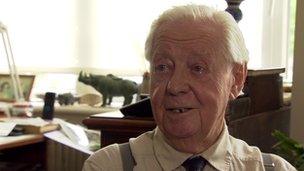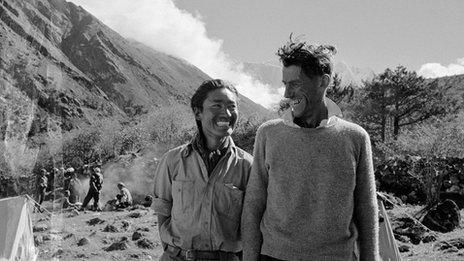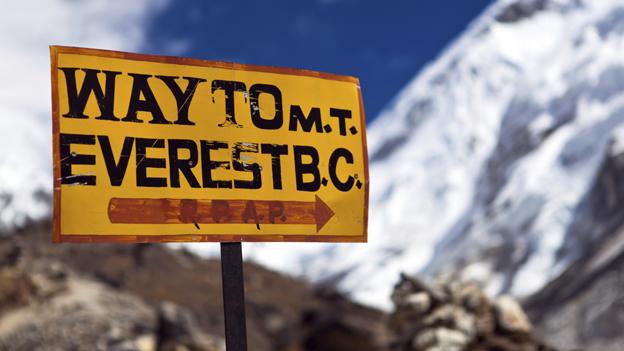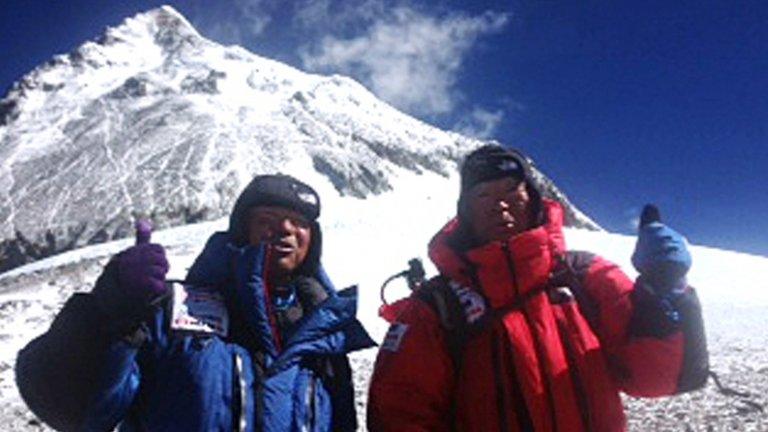Journalist recalls the battle to break Everest story
- Published
As Edmund Hillary and Tenzing Norgay became the first people to scale Mount Everest 60 years ago, a fierce battle raged among journalists vying to report the story.
For decades, Everest had been the ultimate climbing goal and reporters were desperate to break the news first.
The Times newspaper sponsored the expedition and had exclusive access to the climbing team.
When word arrived that Hillary and Tenzing had succeeded, their correspondent, James (now Jan) Morris, wanted to get his message down the mountain before his rivals.
Morris's closest competitor was Reuters correspondent Peter Jackson.
Now 87 and living in south London, Jackson has told the BBC how - in spite of the Times's hold on the story - he still became the first journalist to take photographs of the climbers and get them published.
He has kept all his pictures in a cardboard box for the last 60 years, and most have never been published until now.
Agonising wait
Several of the pictures show his long and arduous journey across the Himalayan ranges towards Everest to cover the story.
He needed 11 porters to carry his equipment and supplies - one just to carry a heavy box of coins because the hill people did not use paper money, and another to carry a portable radio and spare batteries.
After several weeks of climbing and perilous river crossings, Jackson arrived at the Thyangboche Monastery.
The monks there looked after him while he waited for news.
It was agonising not knowing what was happening to the climbers, he told the BBC.
"I sat out under the sun with a wonderful view of Everest but not learning a thing because the Times insisted on not telling anyone," he said.
Two weeks later, a messenger raced through the monastery with an urgent despatch.
Jackson discovered the runner had been offered 200 rupees to get to Kathmandu in six days and he suspected the mountain may have been climbed.
Tricky Times
He trekked down to the small town of Namche Bazar where an Indian police officer manning communications let him see the message.

Peter Jackson now lives in south London
It was from the expedition leader, Colonel John Hunt.
"It said, 'snow conditions bad, advance base abandoned, yesterday'," Jackson recalled.
"The policeman said I could send a message as well but I didn't. I knew it must be wrong as I thought they had got to the top."
On the trail back to the monastery, Jackson said he met Morris heading down to Kathmandu, and the Times reporter claimed the expedition had failed.
The next day, All India Radio announced Everest had been conquered and the Times was able to break the news on the day of the coronation of Queen Elizabeth II.
Jackson's hunch had been correct - the message had been sent out in a pre-arranged code.
"Snow conditions bad" meant Hillary, and "advance base abandoned" meant Tenzing. Morris had not taken photographs and was rushing to Kathmandu to file his story.
Iconic picture
Jackson then waited for the climbers to come down to the monastery and was thrilled to be able to meet them.
There were no other journalists in this remote place, and it was there he interviewed them and took the iconic picture of Hillary and Tenzing smiling at each other.

Peter Jackson took this famous picture of Tenzing and Hillary
He said: "Hillary said to me, 'I feel very happy, I feel bloody good'. I changed it to 'damn good' as they wouldn't have printed it otherwise.
"Tenzing said he was happy but not tired... and having attempted the Everest climb seven times, he said he wouldn't do it again."
Jackson spent the night with the team and then followed them down to Kathmandu, taking more pictures.
Hillary and Tenzing were mobbed along the route - crowds flocked to meet them, and hordes of journalists tried to speak to them.
Still in their expedition clothes, the climbers and Col Hunt had an audience with King Mahendra of Nepal.
'Warm congratulations'
Locals drew a banner showing Tenzing on top of Everest with Hillary nowhere in sight, and there was much nationalistic speculation over who had actually set foot on the summit first.
Jackson said he had been told the two climbers worked as a perfect team and had got a few feet from the top together.
Tenzing had then apparently told Hillary to go up to the summit first, before Tenzing himself stepped up carrying the flags of Britain, India and Nepal.
The expedition included an official photographer, but his work was published after the team got home.
Jackson's work was splashed first across the Sunday Express and then newspapers all over the world.
Soon after, he received a telegram from Morris of the Times.
It said: "Ed Hillary and I send our warm congratulations. Here's to our next adventure!"
- Published29 May 2013
- Published29 May 2013

- Published28 May 2013

- Published27 May 2013

- Published23 May 2013
